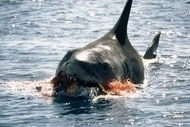Create a free profile to get unlimited access to exclusive videos, sweepstakes, and more!
No males? No problem: Shark in all-female tank just gave birth to a daddy-free mini-Jaws

Aquarium enclosures are closed systems; as a general rule you don’t expect to find something living inside, unless you put it there yourself. So aquarists at the Cala Gonone Aquarium in Sardinia, Italy were in for a shock recently when a tank which previously held two smoothhound sharks, suddenly had three.
In addition to the two adult sharks which call the tank home, the keepers found a baby smoothhound. That wouldn’t be surprising — you put two members of the same species in a room (or a tank) together long enough and you might get babies — except that both of the adult sharks in the tank are female. It’s the sort of event you usually find in religious texts or Sith lord origin stories, not in shark tanks.
“We woke up in the morning and opened the aquarium in June. The aquarist went inside the aquarium and realized there was a small shark,” Flavio Gagliardi, director of the Cala Gonone Aquarium, tells SYFY WIRE. “We entered the big tank and took it out because it could be eaten by bigger fish. We moved her into another tank alone.”
They named the new arrival Ispera, Sardinian for “hope,” and plan to move her back into the tank with the two adult sharks once she’s grown large enough to fend for herself.
As incredible as it seems, these so-called virgin births aren’t all that unusual. They’re the result of a process known as parthenogenesis, the ability of females of some species (including reptiles, some birds, and of course sharks) to self-fertilize when the occasion calls.
Parthenogenesis has been observed in a number of shark species in captivity, but the Cala Gonone Aquarium birth is the first documented case in smoothhound sharks.
PARTHENOGENESIS
Meaning “virgin creation” in Greek, parthenogenesis refers to a process in a variety of animals which allows them to reproduce asexually. Some species, like the whiptail lizard, reproduce entirely parthenogenically. Like the dinosaurs in Jurassic Park, the species is 100% female. Scientists have long-wondered how they avoid the genetic stagnation which we’d expect to arise from what appears on the surface to be a clonal process.
In the case of whiptails, they get around the problem by starting with a more robust set of genes than their sexual relatives. Whiptails start the reproductive process with twice the number of chromosomes and recombine them in such a way that avoids pairing homologous genes. How they do this isn’t precisely understood.
Other species, like some snakes, Komodo dragons, turkeys, and a variety of sharks, utilize parthenogenesis on a case-by-case basis. They appear to prefer sexual reproduction for the genetic diversity it offers but will reproduce asexually when needed. How often this occurs in nature isn’t known, and most documented cases happen in captivity where individuals are more-easily observed and isolation from a potential mate is more prevalent.
While sexual reproduction occurs via the combination of an egg and sperm cell, parthenogenesis in sharks takes a different tactic. One way this happens involves a secondary reproductive material called polar bodies. The egg, which contains only half of the required genetic material, combines with a polar body in the same way it would normally combine with a sperm cell. This, and similar processes, are known as automictic reproductive strategies and allow for some recombining of genetic material, resulting in offspring which is not genetically identical to the mother.
The common wisdom is that parthenogenesis is a survival strategy of last resort. Should an individual be isolated from suitable mates, either by natural processes or by human intervention, it allows for the passing-on of genetic material to a new generation, maintaining the species. Though there is some debate among the scientific community, owing to its appearance even in instances where suitable mates are available.
In a study involving copperhead and cottonmouth snakes, researchers observed females reproducing parthenogenically even when males were present. Warren Booth, the head author of the study noted, however, there may be other factors at play. While males were present, they may have passed over the particular female, leaving her no option but to take matters into her own… lack of hands.
The staff at Cala Gonone aren’t equipped for research, but the sharks are being studied. “We are a small aquarium, we don’t do research,” Gagliardi says. “We keep in touch with some universities and research centers in Italy and Europe. We sent [samples] of the animals, the two females and Ispera, to a lab in Turin which specializes in genetic studies. We are waiting for their results.”
That center, according to Gagliardi, is utilizing the same process of genetic analysis which was done for a parthenogenically born zebra shark in Townsville, Australia. In the meantime, Ispera is doing well.
"Ispera is doing pretty well," he says. "Eating well, growing up. From what we can tell, she’s in very good condition."



























